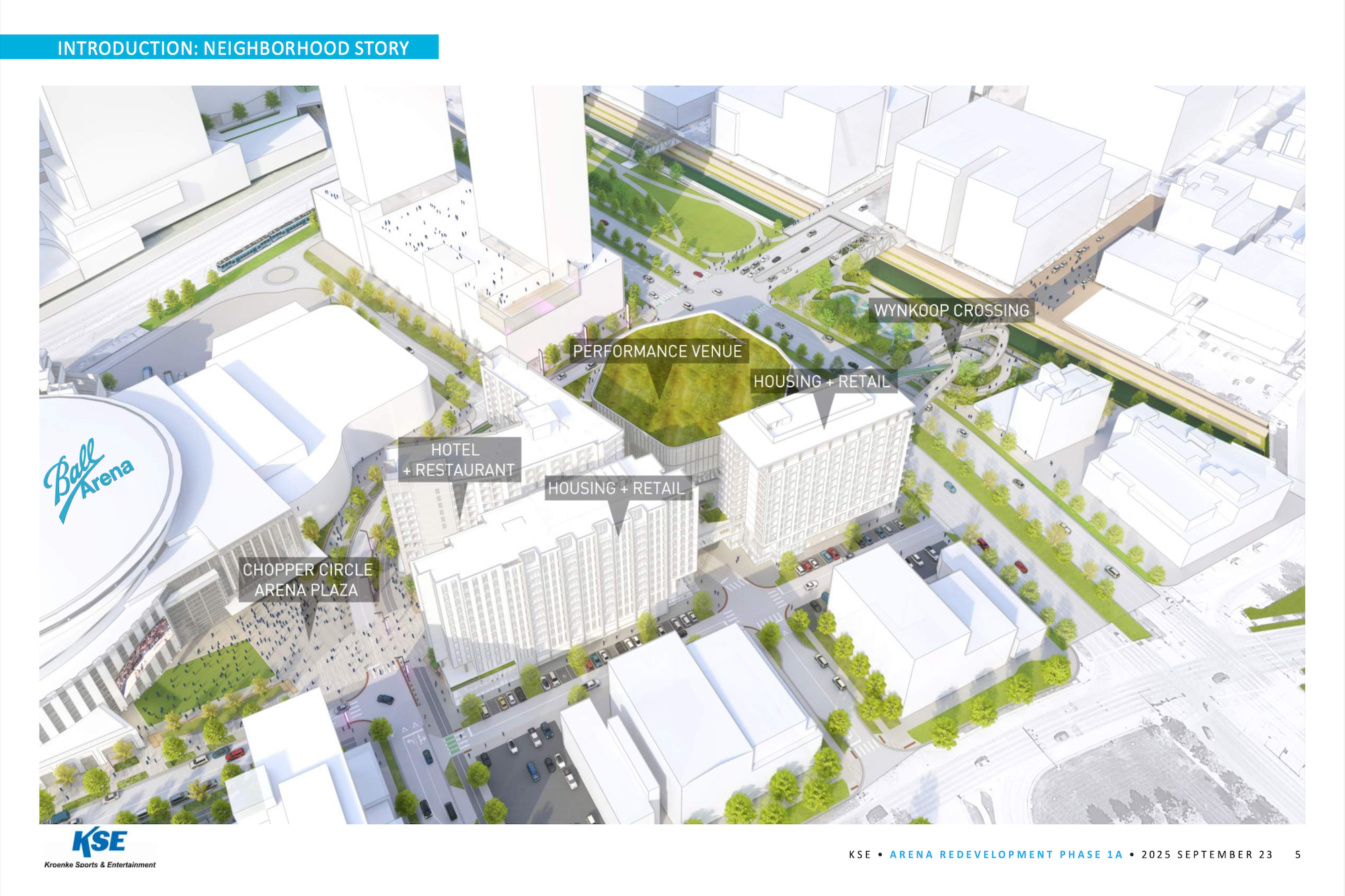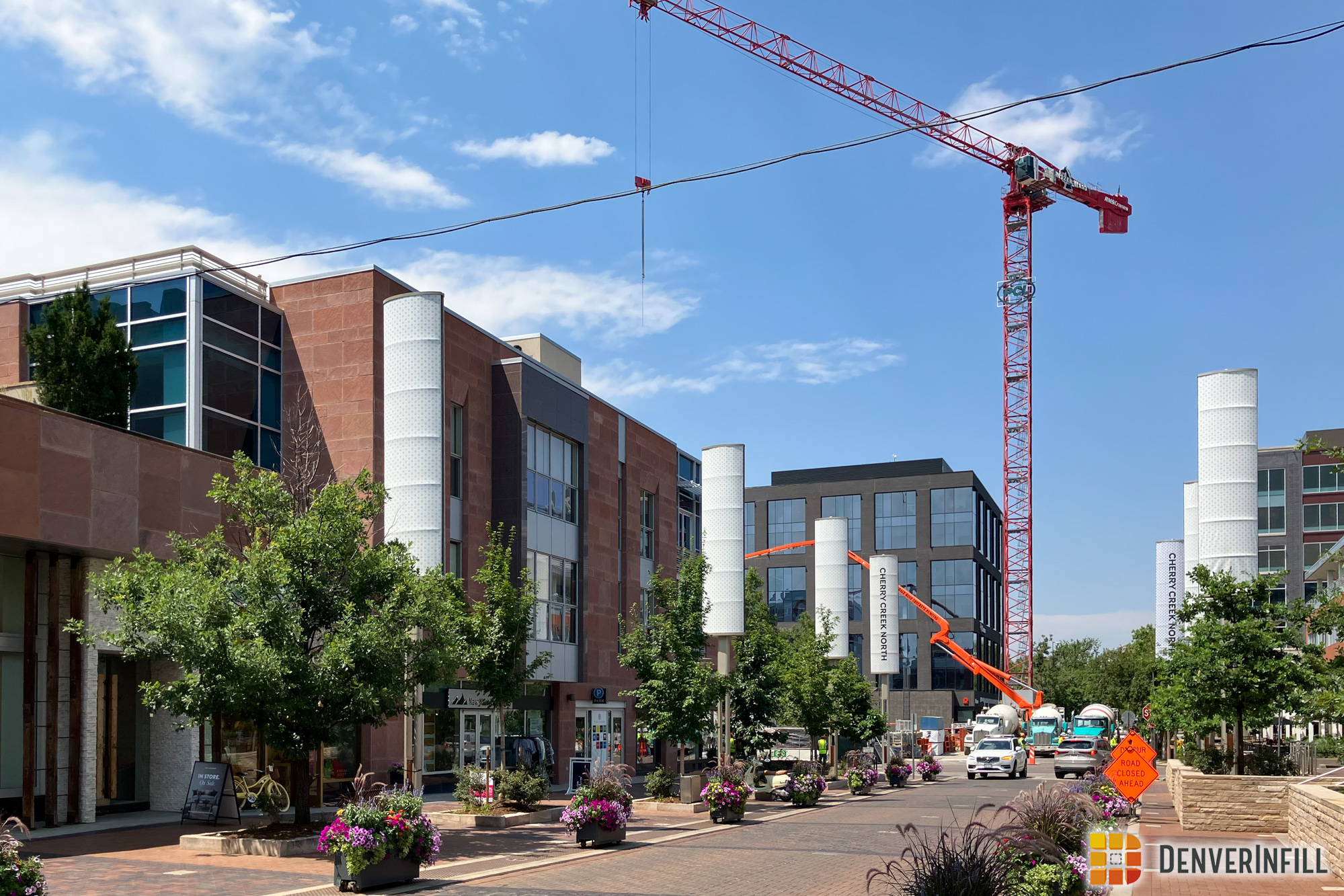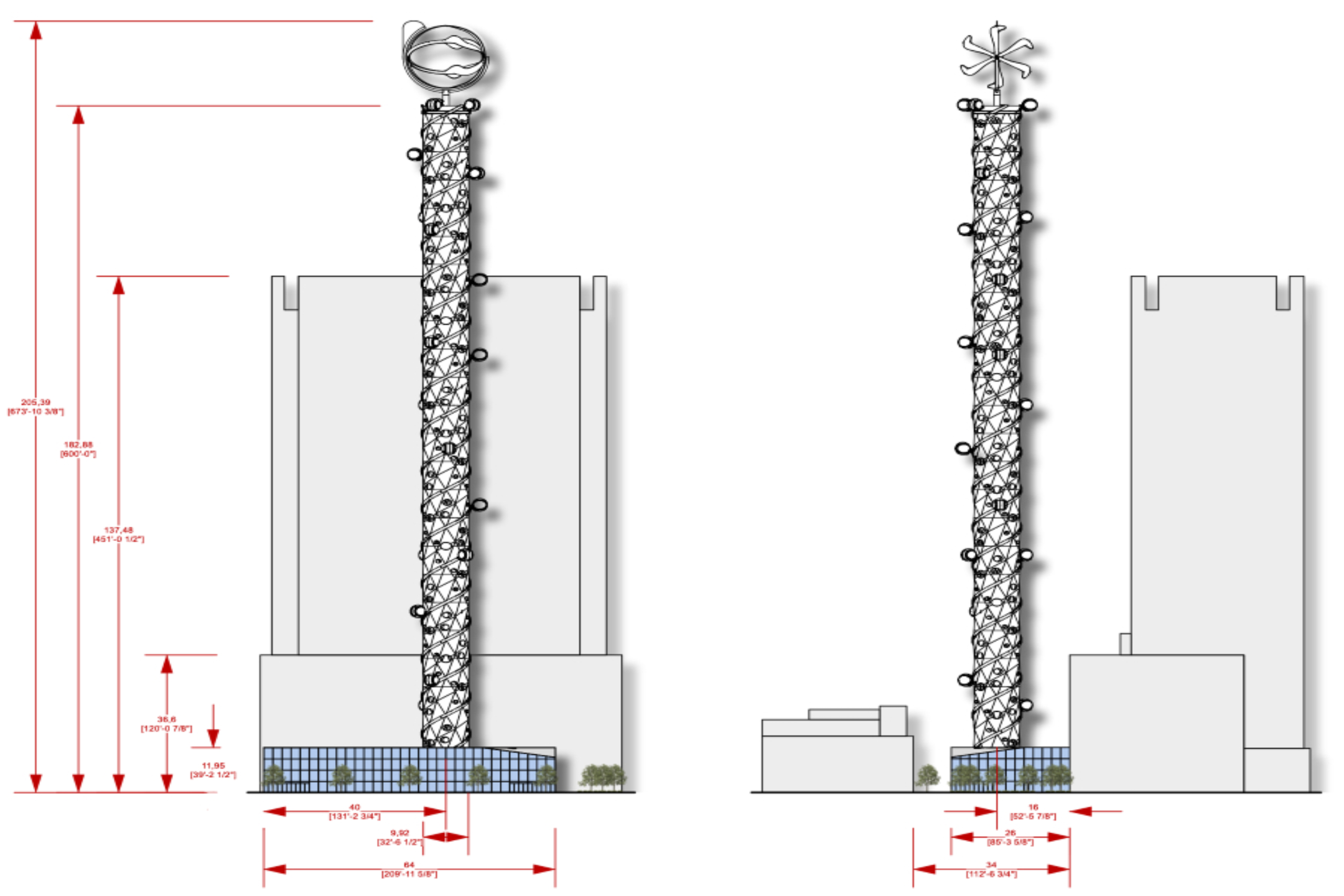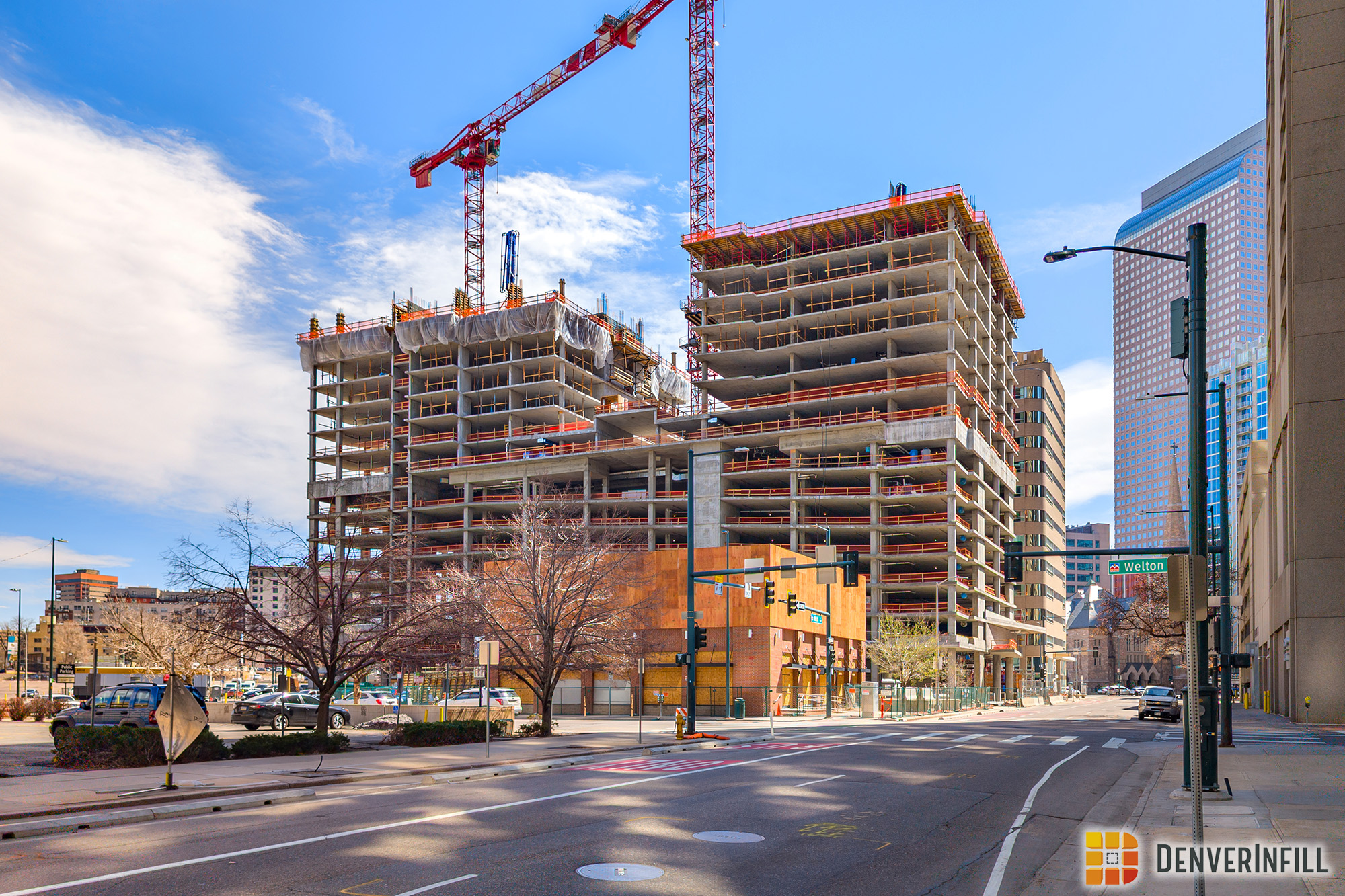Yesterday we took a look at the 250 Columbine project and today we are walking across the street to take a look at another new redevelopment project: 245 Columbine. Below is a map of the area with the site outlined in yellow.
245 Columbine will be a 7-story, 90,000 square foot office building with ground floor retail. A zoning change had to be filed with the city and it was approved unanimously 11-0 despite many concerns from the local residents. Here are some preliminary renderings of the project.
Right now the old Cherry Creek post office building occupies the site which will be demolished to make way for the new development. I don’t think anyone is going to miss this building,
Here is a top down view of Columbine Street looking toward 245 Columbine. Between 245 Columbine and 250 Columbine this street will become quite the dense stretch in Cherry Creek North.
This project will have several floors of underground parking and is designed by klipp Architects. 245 Columbine is expected to break ground this summer/early fall.

















Why would they tear down that beautiful building? Juuuuuuust kidding.
Those ghost people poking out of the decks are kinda spooky. I think they’re watching me.
A few months ago I saw signs in the neighborhood there about developing smart.
I think their biggest concern in that area is a real one; this will add to traffic. Right now the intersection that leads into the stacked parking garage is a mess. This has little to do with what is proposed for development (which I feel looks like a great improvement!) but instead has to deal with the poorly designed parking and road system for the demands of the local area.
I will miss the post office, or rather, I will miss the unpretentious, low-rise, quirky neighborhood that it was once a part of. I remember stopping in front of the post office many times when I was a kid and leaning out the window to stuff a bundle of letters that my mother handed me from the drivers seat into the curbside mailboxes. Then we would head to the Tattered Cover, or a little eatery, or a crafts or toy store. Some of these things still exist in CCN, but as the amount of Lexus SUVs and granite and glass buildings has risen, the whole neighborhood has taken on a character that feels unwelcoming to those who don’t have the money to shop at its exclusive outlets. Redevelopment is great and its nice to see Denver getting a bonafide urban subcenter, but it’s a shame that this area of town has tilted so much in the direction of exclusive luxury developments. Meanwhile, the surrounding residential areas have been decimated by urban mcmansions of the most distasteful sort.
Thank you. I’m in 100% agreement, particularly with the comment about CC being unwelcoming to anyone making a mere 5-figure income. Shiny new buildings do not a great city make, not if everything that makes a neighborhood unique are erased completely (that said, this post office building had to go!). My favorite old Cherry Creek memory (aside from many, many hours spent at the Tattered Cover, both as a customer and as an employee) is from the early 1970s when I was a small child: Shakey’s Pizza. The building, at 2nd & St. Paul, is still there, although impossible to recognize now. But there are plenty of websites and Facebook pages for old Denver nostalgia, so I’ll leave it at that.
In some ways I agree with Sam and Mark — the Cherry Creek of my own childhood (I’m 30) is quite different than it is today. Presumably that contrast is stronger the longer you’ve lived in Denver. However, it is really dangerous to try to protect neighborhoods based strictly on nostalgia.
Protecting legitimately historic buildings (i.e. more than 100 years old) is something that should be deeply considered, or even required. On the other hand, preserving the scrappy and folksy feel of a neighborhood, while well intentioned, seems more fake and silly than the neighborhood filling with BMWs and plastic surgery shops through more market-driven means.
There will always be places in Denver where people who do not make significant incomes can live. There will always be places in Denver where kids and parents can shop on-the-cheap together. There will always be places in Denver where awesomely scrappy punk bands can play. There will always be places where an indie store can set up shop and actually compete against bigger chains. Those things are important, but them happening at the intersection of 2nd and St. Paul is not important. Let the neighborhood change, even if it becomes a rich-only enclave. Awesome places will find a home elsewhere, if necessary.
Great writing, Ryan, Sam and Mark. True, the longer you’ve lived in Denver, the stronger the contrast of change. (I’m pushing 70) In the 50s, Cherry Creek was the first high-end shopping center outside Downtown, while Daniels & Fisher, then the Denver Dry Goods, then May D&F faded and died downtown. Location is everything, and with the Denver Country Club and its adjacent mansions to the West, the Polo Grounds just over Cherry Creek to the South, plus DU, Hilltop to the East, the little commercial strip along First and Second became the true Urban Village. Artsy. Urbane.
My first apartment in Denver was at 19th and Pearl, then I moved South to 11th and Clarkson. On my bike, I’d get to Cherry Creek through Cheesman Park, then East on grand, divided 7th Avenue, then down to the village next to the old shopping center. I’d get haircuts from a barber who had a little second-story shop on 2nd, with stairs coming up from the back lot, which was gravel. Dave is long-gone, and so is the little building, which was flanked by huge cottonwoods.
I have lots of extended family and friends connections all around there, and I lived all over — Wash Park, then to Southeast Denver and eventually our first townhouse, along Happy Canyon, just North of the Tech Center. The cultural, commercial crossroads of Denver’s affluent belt – from Capital Hill down to Cherry Hills Village – is North Cherry Creek.
The upper-income population of Denver lives and works mostly in that wealth belt. East Cherry Creek is already taller, denser than Cherry Creek North. And further East, along Colorado Boulevard and in Glendale, much taller and denser, all the way to the Tech Center and beyond. This urban-suburban infill will continue for decades.
When I left Denver for the East Coast in 87, the old shopping center was about to be torn down and rebuilt, swankier than before. This wealth concentration will escalate, but it also creates a lot of jobs. And Ryan’s right — there will always be plenty of affordable neighborhoods for those retail, restaurant and office workers.
There will be growing pressure for rail connections in-out of Cherry Creek. Wealthy, powerful interests may try to block routes, but as the urban fabric of the city weaves into more connected density, those narrow streets in the area will create more demand for rail, the best alternative to the car. Bikes already rule in NCC.
Ken’s point, that each infill project is but a pixel on the wide screen of an entire city, makes us look at the big picture. And on his recent podcast, he mentioned the way we take in the broad, urban streetscape, what he calls “streetwalls”: 90 percent of the urban buildings almost anywhere are “background” buildings, in our wide-angle lens perceptions.
Cherry Creek North looks Urban Village to me. When I focus on key buildings, like the Tattered Cover, I remember moments in those places. New buildings, new experiences. A very different kind of infill from Downtown. Here, smaller older buildings give way to bigger, taller ones — but it’s not shocking change. It’s expected, like a kind of destiny. Around Downtown, out of a broken sea of surface parking lots and industrial abandonment, rise five, ten and 20-story buildings that house thousands of apartments and condos, new offices for many thousands of workers, entire new neighborhoods around supermarkets and cafes. Big change, brand-new next to old.
Cherry Creek, exclusive and wanting to be. Downtown, crossroads for all classes, mixing on the Mall and on the platforms of trains from all over. Not an urban village, a city.